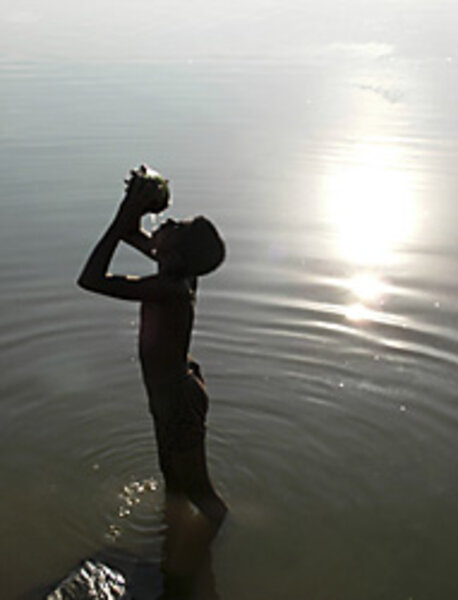On World Water Day, a mighty global thirst
Loading...
Oceans splash across most of the earth's surface. But they contain saltwater, unfit for human consumption. Only a tiny fraction of the world's water – about 2.5 percent – is drinkable. That still would be an ample supply if it were clean and available where needed.
It's not. Today some 1.2 billion people lack access to safe drinking water and 2.6 billion lack proper sanitation (adequate sewage disposal). As a result, tainted water supplies are blamed for the worldwide deaths of 1.8 million children, according to the United Nation's Human Development Report for 2006. That's 4,900 children per day under 5 years old (the number of children under 5 who live in New York and London combined).
What's more, children worldwide miss 443 million days of school each year because of water-related illnesses. The UN also estimates that half of the world's hospital beds are occupied by patients suffering from water-borne diseases.
Beyond that, millions of people (almost always women) wearily spend hours per day carrying water up to several miles for their family's needs because no source is close at hand.
Since 1992, the UN has sponsored World Water Day, this year being observed Saturday, March 22, to raise awareness of the need to protect and improve access to clean water supplies.
"When the well is dry, [then] we know the worth of water," said Benjamin Franklin, long before today's water challenges.
It's clear that competition for water "will intensify in the decades ahead," said Kemal Dervis, administrator of the United Nations Development Program in its 2006 report. "[W]ater is the ultimate fugitive resource, traversing borders through rivers, lakes, and aquifers – a fact that points to the potential for cross-border tensions in water-stressed regions."
Growing populations, which spur demand for more industries and farmland, are draining water resources. And climate change is expected to exacerbate the problem as it alters rainfall patterns (see page 17). A new UN study shows that as temperatures have warmed, the world's glaciers have begun retreating at accelerating rates and may disappear entirely within a few decades. China, India, and the West Coast of the United States are among populous places that rely on glacial meltwater for their water supply. Glaciers feed some of the world's great rivers, such as the Ganges, Yellow, and Mekong, which serve 1.5 billion people.
One of the UN's Millennium Development Goals, established in 2000, is to cut in half by the year 2015 the proportion of people unable to reach or afford safe drinking water.
Achieving that goal is "critically important," says UN Secretary-General Ban Ki Moon. "When you look at the health and development challenges faced by the poorest of the world's population – diseases like malaria or TB, rising food prices, environmental degradation – the common denominator often turns out to be water."
Governments and private groups are working hard to address the problem as well. One promising initiative in India uses ancient reservoirs, called erys, to collect rainwater.






